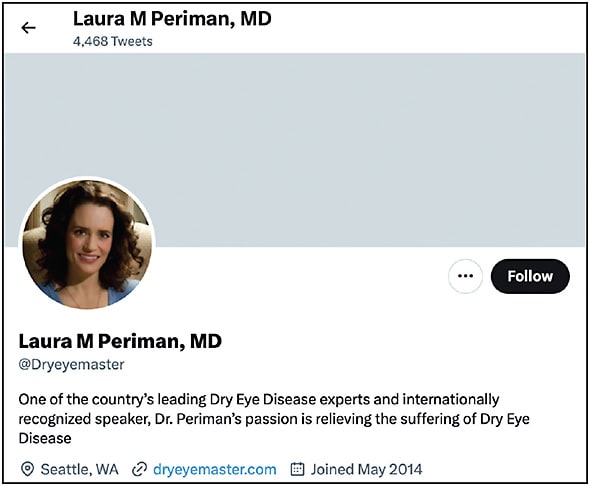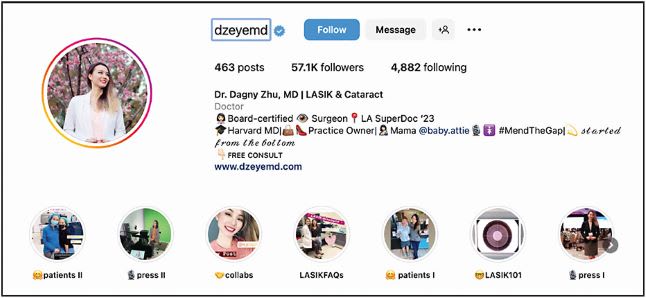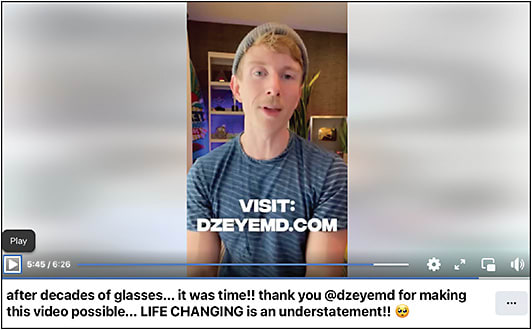With over 4.2 billion active global social media users worldwide1, social media (e.g., Instagram, YouTube, Twitter, TikTok, and LinkedIn) has become an invaluable tool for growing the modern-day medical practice. The reasons:
- The traditional marketing strategies of using mailers, billboards, magazines, television, and radio advertisements can be costly. Social media can be free. (See, “Pay to Play”.)
- Social media marketing has the potential to reach more people than the traditional marketing strategies, given that online posts can be shared to a vast audience.
- Patients are turning to the Internet to find medical providers and health information, with up to 74% of American adults using the Internet as their first source for medical information.2,3
Nearly 40% of ophthalmologists report they use social media in a professional context.4 Thus, it has become more important than ever for ophthalmologists to build a social media presence to attract and retain patients and become recognized among colleagues and industry. Connecting with peers and industry can contribute to professional fulfillment and practice growth, due to opportunities for networking, consulting, and job searches in ophthalmology,4 according to a survey I helped conduct in 2022.
PAY TO PLAY
While it is entirely possible to grow organically via a social media algorithm without using any paid services, with so many players in the space, it can be hard to get content seen.
Another option is to pay for sponsored social media posts on Instagram and Facebook. Similar to Google Ads, the ophthalmologist’s content can be shown to a predeterined number of people who match specific criteria, including age, gender, location, or interests.
The drawback to this option is that, unlike organic posts, paid content is shown with a “sponsored” or “ad” label that takes away from the authenticity of the post.

Here, I provide the step-by-step action steps that enabled me to build my social media presence.
1. Determine/Establish Your Brand
One’s brand is the image the consumer has of the business owner and/or their business, according to “The Business Owner’s Playbook,” by The Hartford, a property and casualty insurance company.5
To establish the brand, the ophthalmologist needs to define it. To accomplish this, I recommend the doctor ask themselves, “what are the unique features that set myself and/or my practice apart from similar eye care providers in my local market?”
The answer can include having unique or advanced technologies, elevated customer service, and/or specialized training and expertise. The brand becomes fixed in the mind of the consumer, based on the accumulation of the content the ophthalmologist chooses to post.
2. Create a Unique Handle
Regardless of whether the ophthalmologist will be immediately active on a social media platform, they should create an account on each of the major ones (named above), so they can claim their unique handle (i.e., a memorable username that reflects their brand) before it is taken by someone else.
The ophthalmologist’s profile on the social media platform should include a brief description of what they do and why it’s unique (their brand), along with their practice’s contact information, whenever possible.
Remember, the goal in using these social media platforms is to attract followers and convert them into loyal patients and interested colleagues and industry professionals.
I have found that physicians typically use part of their name plus “MD” or “doctor” to assert their expertise, but the ophthalmologist should feel free to be creative. For example, my colleague, Laura Periman, MD, has the Twitter handle @Dryeyemaster .
The ophthalmologist’s handle should be consistent across multiple platforms, including their website, so potential and current patients, colleagues, and industry professionals can easily find and identify them.
It is also appropriate for ophthalmologists to create 2 separate accounts, 1 for them, as the individual, and 1 for the practice, especially if they are a part of a large group practice where there are, therefore, several different doctors on staff.
As a brief aside, I have found that, in general, followers of the individual doctor accounts tend to grow quicker because followers relate more to a person rather than an entity.
Additionally, I recommend the ophthalmologist link their social media accounts to their website and vice versa. This way, the patient who happens to land on the practice website can learn more about the physician through other platforms and subscribe. (Likewise, many of my social media followers click on the website link in my profile to schedule a consultation.)


3. Know Your Audience
Each social media platform caters to a slightly different audience, so the ophthalmologist will need to tailor their content to each audience. I find that the best platforms to reach patients are TikTok, Instagram, and YouTube, while the best platforms for networking with industry are Twitter and LinkedIn. Moreover, the demographic for Instagram and TikTok tend to be younger (i.e., more likely to be refractive surgery candidates), whereas Facebook and YouTube users are older (more suitable for cataract and lens-based procedures). Additionally, the social media platforms have varying levels of formality, with TikTok being the most informal, and LinkedIn being the most formal.
4. Create Engaging Content
As only the most engaging content will be shared by the social media platform to garner more views and, thus, followers, it’s important the ophthalmologist craft engaging content. After all, social media platforms are built on algorithms. How do these platforms decide on the engagement of content? Essentially, they utilize analytic tools and artificial intelligence to measure the number of likes and comments a post receives immediately after it is posted. From there, the algorithm decides whether to show the post to more people. This influences the post’s and, thus, the ophthalmologist’s, ultimate reach.
So, what comprises an engaging post? I have found that photos, videos (catchy, less than 1-minute videos perform the best), and creating relatable personal content have created followers to build my social media presence.
Regarding photos and videos, a study I co-authored on ophthalmologic content on Instagram showed that posts related to the doctor in a white-coat selfie, received the highest engagement.6 Meanwhile, the least engaging posts were those that were purely educational and/or included just a slit-lamp photo. This study’s findings suggest that being personable and educating through storytelling on Instagram, specifically, packs more of an engagement punch, which, again, can lead to more followers.
POSTING CAVEATS
It’s important to remember that everything posted online lives on forever “in the cloud,” so the ophthalmologist needs to be comfortable with a patient, coworker, and/or employer seeing what they post. Additionally, ophthalmologists should consider the timing of their posts. It could hurt their professional reputation for a patient to see a story about the MD’s weekend shenanigans as they wait to be seen for a visit, for example.
Two more caveats: (1) Ophthalmologists should never provide medical advice, and (2) never share any personal identifying details about a patient and/or their case in a social media post without the patient’s permission to do so.
Regarding the former, it is a huge liability risk to the ophthalmologist because they do not have sufficient information to make an informed recommendation. Similarly, while the ophthalmologist can use social media to provide general eye education to the public, they should refrain from answering messages from individuals seeking specific medical advice and, instead, recommend that they seek professional medical care in-person. It is also good practice for the ophthalmologist to attach a disclaimer, for example, “views do not represent medical advice” on all social media posts.
When it comes to sharing any personal identifying details about a patient and/or their case in a social media post without their permission, this is a violation of the Privacy Rule of the Health Insurance Portability and Accountability Act (HIPAA). Failure to comply may result in civil money penalties and criminal prosecution.10 Even sharing a de-identified story about a rare condition combined with the time and/or location a patient was seen may be enough information to constitute a HIPAA violation.
To get a patient’s permission to enable the ophthalmologist to post about their case, it is imperative the doctor ask the patient to sign a HIPAA-compliant media consent and release form. Examples can be found via an online search. I also like to include a disclaimer that reads: “Posted with patient consent” for any post that features a patient.
When it comes to creating relatable personal content, I have posted on my personal social media accounts that I was raised by a single mother and grew up in an immigrant family. This too created several followers, as many social media users can relate to those circumstances. In fact, many of my LASIK and ICL patients said they had followed me for years on social media, and came to me for surgery because they had developed trust in me.
5. Post Regularly
It’s no secret that consistent posting on the social media platforms the ophthalmologist chooses to use is required for both gaining and keeping followers. On Instagram, Facebook, Twitter, and LinkedIn, posting is recommended between 3 to 7 times per week, 1 and 2 times a day; 1 and 5 times a day, and 1 and 5 times a day, respectively, according to Hootsuite, an automated social media posting platform.7 TikTok recommends posting 1 to 4 times a day.8 For YouTube, video uploads are recommended 3 or more times per week.9 But in my experience, posting consistently just a few times a week is sufficient for most platforms.
I have found that creating a social media content calendar can aid in sticking to a schedule, while also allowing for great thought behind each post.
Of course, ophthalmologists are all busy doctors who have full-time day jobs. So, it’s important they give themselves grace and take a break from their social media platforms, if managing them becomes cumbersome or begins to affect their mental health.
If needed, it can be helpful for the ophthalmologist to outsource social media posting to a social media manager or digital marketing company. Many can be found through social media and Google. In fact, I receive direct messages from these companies every day advertising their services. However, it’s important to maintain control over your content to keep your voice. I use a social media assistant who helps me edit videos and format my content, but I always edit, review, and approve the final version. Content that comes across as ingenuine will significantly harm the ophthalmologist’s social media presence and, therefore, hinder their professional growth. (See “Posting Caveats”.)
6. Engage with Others
Posting engaging content regularly is not enough to build a social media presence. The ophthalmologist must also engage with others. This can be accomplished by tagging similar social media accounts when posting content, replying consistently to comments and direct messages, and by participating in organized social media hashtag campaigns with other ophthalmologists on eye health and safety topics. (Such campaigns can be found on Instagram when searching keywords under “hashtags.” They are also usually listed at the beginning or end of each caption.)
As an example, in 2020, the American Academy of Ophthalmology led a social media campaign against law enforcement’s use of rubber bullets under the headline “Using your voice shouldn’t mean losing your vision” and engaged hundreds of ophthalmologists in reposting and spreading awareness under the hashtags “#NotOneMoreEye” and “#NoRubberBullets.”
7. Collaborate with Influencers
Another strategy for the ophthalmologist to build their social media presence is to collaborate with influencers. Simply direct message (DM) the creator, or send an email to the address they list on their profile.
For example, I performed LASIK on Tyler Oakley, an influencer who has over 5 million followers. In exchange for discounted surgery, he shared his experience on social media with a LASIK Q&A video. (See https://www.facebook.com/watch/?v=757532881615324._ ) That video has garnered more than 100,000 views, which is a powerful form of word-of-mouth referrals.
Incidentally, at the time of the writing of this article, Jeffrey H. Levenson, MD, went viral when YouTube content creator MrBeast saw Dr. Levenson’s TED Talk on preventable blindness and contacted him to participate in the video “1,000 Blind People See for the First Time.” (See this month’s “News” section (p. 6) for additional information on this feat on this social media platform.) Incidentally, as this article goes to press, MrBeast’s current subscribers are 136 million.
Get Started!
Rome wasn’t built in a day, and social media followers won’t be built in a day either. That said, there are too many reasons and benefits for the ophthalmologist not to focus on building their social media presence. I have found by following the action steps provided, every ophthalmologist should have the tools necessary to do so. CP
References:
- Dixon S. Social media -- statistics & facts. Statista. June 21, 2022. Accessed February 3, 2023. https://www.statista.com/topics/1164/social-networks/
- Li C, Chen LJ, Chen X, Zhang M, Pang CP, Chen H. Retrospective analysis of the possibility of predicting the COVID-19 outbreak from Internet searches and social media data, China, 2020. Euro Surveill. 2020;25(10):2000199.
- He B, Tanya SM, Costello F, Kherani F, Shamie N, Zhu D. Navigating personal and professional development through social media in ophthalmology. Clin Ophthalmol. 2022;16:2263-2274.
- Finney Rutten LJ, Blake KD, Greenberg-Worisek AJ, Allen SV, Moser RP, Hesse BW. Online health information seeking among US adults: measuring progress toward a Healthy People 2020 objective. Public Health Rep. 2019;134(6):617-625.
- Define your brand. The Hartford Business Owner’s Playbook. Accessed February 3, 2023. https://www.thehartford.com/business-insurance/strategy/business-branding/defining-business-brand .
- Huang AS, Abdullah AAN, Chen K, Zhu D. Ophthalmology and social media: an in-depth investigation of ophthalmologic content on Instagram. Clin Ophthalmol. 2022;16:685-694.
- McLachlan S, Cohen B. How often to post to social media. Hootesuite. June 16, 2021. Accessed February 3, 2023. https://blog.hootsuite.com/how-often-to-post-on-social-media
- Editorial Team. Creative solutions: the ultimate how-to guide. TikTok for Business. August 13, 2021. Accessed February 3, 2023. https://www.tiktok.com/business/en/blog/tiktok-creative-ultimate-guide
- Vest J. 15 tips for growing your YouTube channel. Social Media Examiner. January 4, 2018. Accessed February 3, 2023. https://www.socialmediaexaminer.com/15-tips-growing-youtube-channel .
- Summary of the HIPAA Privacy Rule. US Department of Health & Human Services. Accessed February 3, 2023. https://www.hhs.gov/hipaa/for-professionals/privacy/laws-regulations/index.html .









